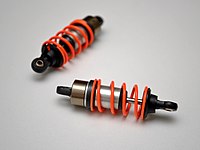
Photo from wikipedia
Rubber and rubber-metal vibration isolators are widely used vibration isolation systems in marine applications. For naval application, shock absorber mounting systems must fulfil two functions. The first one supports the… Click to show full abstract
Rubber and rubber-metal vibration isolators are widely used vibration isolation systems in marine applications. For naval application, shock absorber mounting systems must fulfil two functions. The first one supports the suspended mass in the absence of waving or detonation while providing isolation from vibrations and shock impact. In the second case, during the machine operation, it reduces the force of movement to an acceptable value. Moreover, it returns the insulated mass to the position output without plastic deformation or residual buckling after removing shock stresses or harmonic vibrations. The environment in which marine vibration isolators are to be used strongly influences the selection of a shock absorber. The main environmental problem is the temperature range in marine power plants, which ranges from 20 °C to 55 °C. Temperature fluctuations may cause changes in the physical properties of typical vibration/shock insulators. Both rubbers and elastomers used for shock absorbers tend to stiffen, gain low-temperature damping, and soften and lose damping at elevated temperatures. Factors such as moisture, ozone and changes in atmospheric pressure are usually ignored in shipbuilding. The main environmental factors influencing the ageing of insulators are liquid saturated hydrocarbons, i.e., oils, fuels, coolants, etc., which may come into contact with the surface of the insulators. This work presents the results of the research carried out to determine the effect of overload and the impact of petroleum products on the materials of metal-rubber shock absorbers made of three different rubbers and one polyurethane mixture. For each of the materials, shock absorbers with three different degrees of hardness were tested.
Journal Title: Polymers
Year Published: 2022
Link to full text (if available)
Share on Social Media: Sign Up to like & get
recommendations!